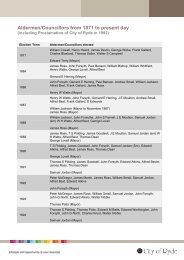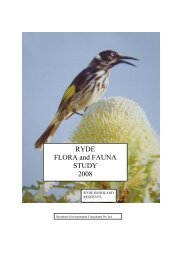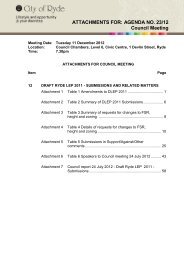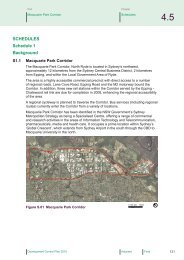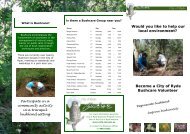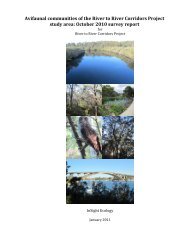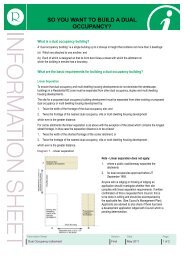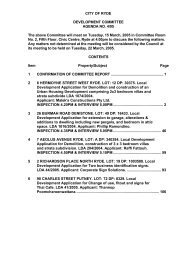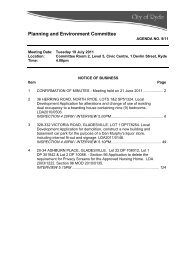RYDE FLORA and FAUNA STUDY 2007 - City of Ryde - NSW ...
RYDE FLORA and FAUNA STUDY 2007 - City of Ryde - NSW ...
RYDE FLORA and FAUNA STUDY 2007 - City of Ryde - NSW ...
You also want an ePaper? Increase the reach of your titles
YUMPU automatically turns print PDFs into web optimized ePapers that Google loves.
Biosphere Environmental Consultants Pty Ltd<br />
<strong>Ryde</strong> Flora <strong>and</strong> Fauna Survey <strong>2007</strong> 30<br />
Other rare or uncommon plants in the area are: Hymenophyllum cupressiforme on<br />
rocks along Terrys Creek with Rhytidosporum procumbens, Rubus parvifolius in the<br />
M2 Motorway overpass area <strong>and</strong> Leptospermum parvifolium (Kubiak, 2005).<br />
Melaleuca deanii, cited in the Oculus report (1999), was observed near the track in<br />
the area below the M2 Motorway overpass. It is listed as vulnerable under Schedule 2<br />
<strong>of</strong> the TSC Act (1995) <strong>and</strong> the EPBC Act (1999). The Bird’s Nest Ferns, Asplenium<br />
australasicum, found along the creek, are most likely garden escapees, as they usually<br />
inhabit gully rainforests canopies or rocks <strong>of</strong> basalt or shale (Benson & McDougall,<br />
1993). The darker, damper <strong>and</strong> high nutrient environment <strong>of</strong> Terrys Creek is suitable<br />
for their growth <strong>and</strong> spread in the area.<br />
The major weed problems occur behind the units above the northern cliff line, along<br />
the stormwater drain within the Road Reserve in Somerset Park, behind the houses on<br />
Crimea Road <strong>and</strong> but mainly along Terrys Creek.<br />
There was a total <strong>of</strong> 103 weed species observed for Terrys Creek, almost double the<br />
amount for the other catchments. To note are the Class 3 weeds Cortaderia selloana<br />
(Pampas Grass) in Lucknow Park, Genista monspessulana (Cape Broom) in Somerset<br />
Park <strong>and</strong> the Class 4 weed Asparagus asparagoides in Pembroke Park while the<br />
majority <strong>of</strong> the creek edge is infested with Privet <strong>and</strong> Trad.<br />
4.5.2 Buffalo Creek / Lane Cove River Catchment<br />
Tozer (2003, p3) states “the Mittagong formation <strong>and</strong> Hawkesbury S<strong>and</strong>stone outcrop<br />
on the margins <strong>of</strong> the study area especially along watercourses where the overlying<br />
shale has eroded during the development <strong>of</strong> a streambed”. Along the Buffalo Creek<br />
corridor there is a topographical gradation from the Wianamatta clay-derived<br />
Turpentine Ironbark Forest in Burrows Park (30-25m ASL) to the s<strong>and</strong>stone-derived<br />
Western S<strong>and</strong>stone Gully Forest in Barton Reserve (30-15m ASL). Also, there is a<br />
topographical gradation from clay dominated Minga Reserve (40-35m ASL) to the<br />
north <strong>of</strong> Barton Reserve (35m ASL). Minga Reserve, Pidding Park, the 2006<br />
Wellington Road quadrat <strong>and</strong> the Upper Strangers Creek quadrat are all at the same<br />
altitude. Pidding Park quadrat, Wellington Road quadrat <strong>and</strong> Upper Strangers Creek<br />
quadrat all contain Turpentine Ironbark Margin Forest while the higher plateau east <strong>of</strong><br />
the cemetery contains Shale S<strong>and</strong>stone Transition Forest (High S<strong>and</strong>stone Influence).<br />
The northwest corner <strong>of</strong> Barton Reserve has not been cut into by the creek <strong>and</strong> has a<br />
patch <strong>of</strong> remnant Turpentine community. However at the north end <strong>of</strong> Barton<br />
Reserve, bordering Quarry Road, the creek cuts deeply into s<strong>and</strong>stone, producing a<br />
vegetation community derived from s<strong>and</strong>y soil.<br />
Further downstream the S<strong>and</strong>stone Gully Forest in Barton Reserve changes to a<br />
topographically lower (10m ASL) Riparian Scrub (Tozer’s Map Unit 35) on<br />
Hawkesbury S<strong>and</strong>stone. This is the location <strong>of</strong> the Coachwood quadrat (see <strong>Ryde</strong><br />
Flora <strong>and</strong> Fauna Study, 2006). The scrub opens onto a silty floodplain that developed<br />
because <strong>of</strong> the l<strong>and</strong>-fill material deposited onto an old tip near the Field Studies<br />
Centre, blocking the natural flow <strong>of</strong> Buffalo Creek. The wetl<strong>and</strong>s opposite the Field<br />
Studies Centre is not natural but has been rehabilitated with Native Reed (Phragmites<br />
australis) in deeper pools <strong>and</strong> Broadleaf Cumbungi (Typha orientalis) on the silt<br />
plugs (McLoughlin, 1993). Closer to Pittwater Road the vegetation changes again to a




